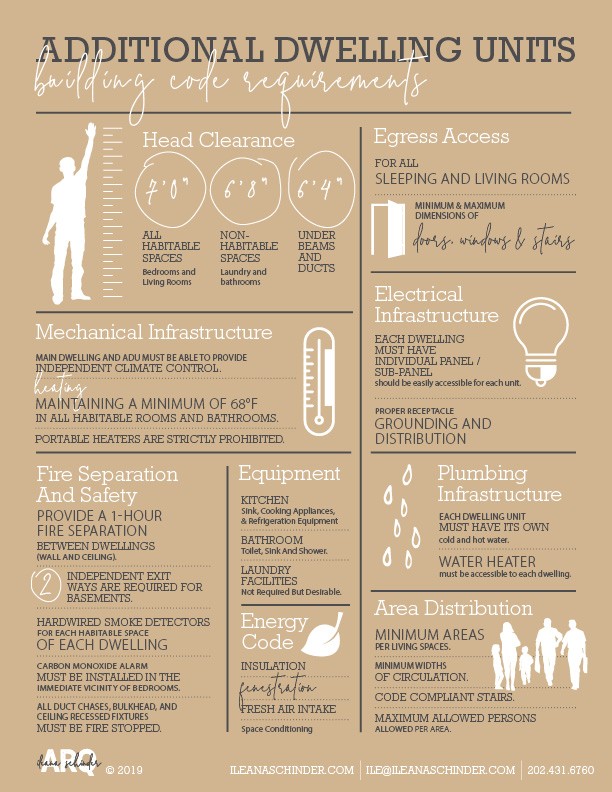What Montgomery County can learn from DC’s accessory apartment policy

A basement accessory apartment. Image by Erin Kelleher used with permission.
Montgomery County is debating a change to its zoning rules that would make it easier to build accessory apartments, also known as Accessory Dwelling Units or ADUs. What impact would such a change have on the area? Thankfully, we can look at our neighbors in DC for clues, since the city passed a similar rule change in 2016.
When accessory apartments (think English basements, converted carriage houses, “granny flats,” and the like) were allowed in DC by-right (meaning no special permissions are needed in certain zones of the city), this had implications for everything from investment to homeownership to aesthetics. We’ll see the long-term results in a decade, but even a look three years later can be instructive. This is what has happened so far:
Clear rules: In 2016, DC allowed accessory apartments to be built in certain residential zones. It established rules on what constitutes an accessory apartment and set the International Building Code as the standard they had to follow. From fire safety to plumbing and electrical, accessory apartments are built to the same safety and comfort standards as the main residence they share a lot with.
Simply put, that means no trailers, tiny houses, or mobile homes are allowed. Accessory apartments must have permanent foundations, infrastructure connections (water, power, and waste) and maintain comfort and environmental levels equals to any house in the District.
Owners and renters: The new rules established responsibilities and obligations both for renters and owners to follow. Insurance, inspections, leases, and enforcement are part of the accessory apartment regulations. Far from the old semi-legal historic apartments where informality was the way to go, the new rules set clear obligations from each party regarding liability, maintenance, lease terms, and shared utility costs. They also provide protections for all parties.
The 2016 rules do not allow for any shared infrastructure (mechanical or electrical), and mandates that both owners and renters have independent services and safety features such as exits, fire separation, and fire protection. The written regulation also allows for inspections from the government to enforce rules around issues like overcrowding and nuisance complaints.
Accessory apartment floor plan. Image by the author.
Interior of this accessory apartment. Image by Erin Kelleher used with permission.
Streetscape: The 2016 rules did not modify the portion of the zoning code that regulates the massing of buildings receiving accessory apartments. Height, setback, and area coverage still stayed within the zoning rules and are enforced by local agencies.
In DC as well as in Montgomery County, zoning and building rules are separate “books” that establish a strict set of rules. Zoning regulates everything that happens from the building envelope outwards, while building codes (The International Building Code used by the Department of Consumer and Regulatory Affairs and Mongtomery Country) regulate everything that happens to the building in the inside.
After the 2016 accessory apartment rules were implemented, the streetscape was minimally impacted: A door to a basement here, an occupied garage there. Every new accessory apartment project was an improvement to a feature that existed before. Most importantly, those features existed in the neighborhood before the new apartments were added. Because of the strict International Building Code rules, tiny homes on wheels or other unsafe conditions remain banned.
Parking: So far, accessory apartment dwellers remain part of the population that is less likely to own a car as shown by research. Part of benefits of living in an urban environment is the access to transit and shared transportation such as bikeshare and ride-hailing. Accessory apartments tend to be located near transit, which allows renters to live car-free and not exacerbate parking issues.
Moreover, DC’s accessory apartment regulations do not allow homeowners to remove existing parking to replace it with an apartment. This rule is strictly applied when a new accessory apartment is about to be added to a property.
Garage turned into an accessory apartment with parking on the side. Image by Erin Kelleher used with permission.
Government agencies: Clear rules for accessory apartments help create fairness for all parties. From housing inspectors to building permit reviewers, all staff have shared common knowledge on how to apply codes, follow regulation and penalize those who break the law in a consistent manner.
Also, homeowners can anticipate what to consider before investing in an accessory apartment in their property. In DC there’s been a learning curve from all agencies, but the learning curve has generated a better understanding on which rule and how to apply it in each case.
Experts: Since 2016 architects, builders, and realtors know how to design, build, and appraise properties that follow the local rules. They have learned which guidelines to follow and how to educate the public about accessory apartment building and zoning codes. Shared efforts between these professional groups have eased the learning curve, allowing them to reduce design time, lower costs, and build to stronger standards set by the local government agencies.
The interior of an accessory apartment. Image by Erin Kelleher used with permission.
So what’s the lesson for Montgomery County? Building accessory apartments did not change the District overnight. They have not created slum conditions, devalued properties, nor created unsafe environments for residents, as some have worried might happen. The regulations have established clear rules for homeowners who want to build a small apartment within their homes.
Due to cost and other factors, accessory apartments in DC remain an incipient answer to housing affordability. So far, less than 100 such units are approved per year, according to the Department of Consumer and Regulatory Affairs. Nonetheless, by allowing accessory apartments, the city gives more residents the opportunity to use their own homes to gain extra income for themselves and to provide housing to others.

